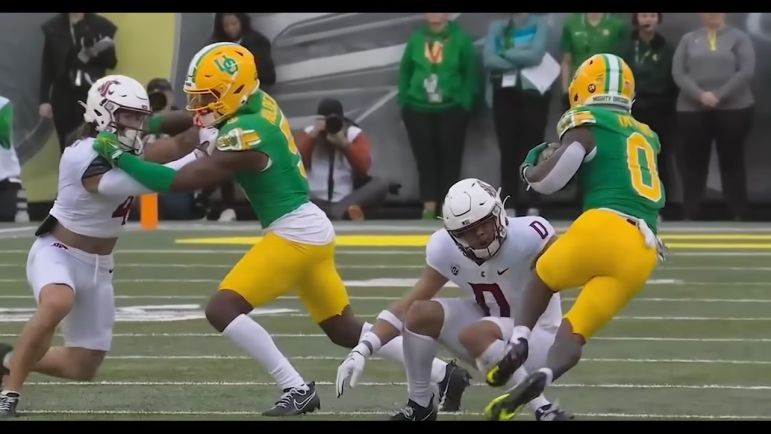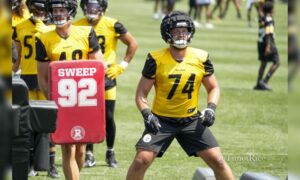From now until the 2023 NFL Draft, we will scout and create profiles for as many prospects as possible, examining their strengths, weaknesses, and what they can bring to an NFL franchise. These players could be potential top-10 picks, all the way down to Day 3 selections and priority undrafted free agents. Today, a scouting report on Oregon RB Bucky Irving.
#0 Bucky Irving RB Oregon – 5090, 192 pounds (Senior)
Senior Bowl/NFL Combine
MEASUREMENTS
| Player | Ht/Wt | Hand Size | Arm Length | Wingspan |
| Bucky Irving | 5090/192 | 9 1/2″ | 29 1/2″ | 70 5/8″ |
| 40-Yard Dash | 10-Yard Dash | Short Shuttle | 3-Cone | |
| 4.55 | 1.54 | DNP | DNP | |
| Broad Jump | Vertical | Bench Press | ||
| 9’7″ | 29.5″ | DNP |
THE GOOD
— Bounces runs to the outside
— Versatile juke package and can make defenders miss
— Fantastic zone vision, reads concepts quickly and proficiently
— Speed to win angles and beat defenders to the sideline
— Secure hands with receiving ability out of the backfield
— True home run threat
— Tough runner for his size
— Evasive in open field
— Very competitive and will fight for extra yards
— Two years of high end production
The Bad
— Height/weight may not meet NFL thresholds, only 192 pounds and 5-9
— Underwhelming draft testing with a sub 30” vertical, 4.55 40-yard dash and 2.11 RAS
— Is too small to shrug off tacklers
— Struggles to pass block and will get moved
— Still developing consistent short yard vision
— Suffers from superman syndrome; constantly tries for 20+ yard gains while passing up easy yardage
Bio
— Turns 22 in August
— 544 career college snaps on passing downs
— 26 career college starts
— 1,192 rushing yards, 6.4 YPC and 11 touchdowns in 2023
— 2,952 rushing yards, 6.2 YPC and 20 touchdowns in college career
— Birth name is Mar’keise
— No significant injury history
— Four-star running back prospect out of Illinois, 13th ranked running back in the nation
— 88.2 overall PFF grade in 2023, 91.8 rushing grade
— All-PAC 12 First Team (2023)
Tape Breakdown
After a star-studded 2023 running back class, this year’s draft is not expected to produce a first-round back. However, teams looking for running backs in the later rounds have plenty of styles to choose from. Among them is Oregon’s Bucky Irving, an exciting and polarizing prospect who will fit zone schemes.
Irving’s standout trait is his exceptional zone vision, a skill honed through Oregon’s diverse zone schemes. He patiently waits for blocking schemes to develop before he shoots through and bounces between gaps. Irving’s ball carrier moves are centered around his juke package. His quick jukes add to his vision in the backfield, where he’ll instantly change direction and attack a different gap.
Below, Oregon pulls the right guard, opening up a hole on the right. Irving sets up the run with an initial plunge to the middle. This shifts the defense inwards and Irving counters with a quick juke to the outside. Irving’s initial hesitation allows the run to develop and leads to a touchdown.
As a runner, Irving wins battles with elusiveness. He’s very shifty and will make defenders miss in the open field. His twitch is evident with 34 runs of 10+ yards this season. With open space, Irving has the juice to break off big plays. NFL teams value ball carriers who are a home run threat, putting pressure on the back half of a defense. Irving does just that, recording 43 runs of 20+ yards during college.
His juice is utilized as a receiving back. Irving was trusted to run a variety of routes and was useful as a checkdown option. He has trustworthy hands, which he uses to flip into easy YAC. When Irving catches a pass, he instinctively takes off with speed to get to the sideline.
Here, Oregon quarterback Bo Nix dumps a pass to Irving. Irving is angled towards the defender and freezes him with a quick hesitation. Within a moment, he’s at the sideline and running down the field. Irving then cuts back to set up a successful swim move. He combines speed, ball carrier moves and lower body fluidity to turn a five yard gain into 25 explosive yards.
No matter how good Irving’s tape might be, it’s hard to persuade teams to take a chance on a back that is under 195 lbs. Many scouts have athletic thresholds, so it’s easy to imagine that Irving may only be draft boards for a handful of teams. Durability is an immediate concern, with running backs taking an absolute beating during their career. Irving is a tough runner, but will struggle to shake off linebackers at the next level.
This is a simple play, but a clear indication why Irving won’t fit any power scheme. Irving tries to truck the defender to gain extra yards. Irving is knocked off his feet as the defender simply overpowers Irving.
While Irving is often touted for his vision, he’s plagued with Superman syndrome, a trait commonly found in top running back prospects. Superman syndrome is when a back is always searching for the explosive, breakaway run and misses easy yards. Irving can unnecessarily break to the outside instead of hitting gaps in the inside. His speed may not translate as well in the NFL, so he’ll need to shift to become a more consistent back.
Teams draft running backs to fit a certain scheme and role. Often, running backs earn extra playing time through pass protection. However, Irving’s frame is too lean to be a consistent pass protector. He struggled to block in the backfield and was taken out of a few big passing downs. Irving’s receiving skills are a main reason why teams are interested in him, but blocking issues makes it difficult for Irving to play on all third downs.
Irving’s tape is electric, so most analysts expected a standout performance at the NFL Combine. Irving ended up as one of the bigger disappointments of the week, running a 4.55 forty-yard dash, 29.5” vertical and a 2.14 RAS (21st percentile). As a prospect who relies on his twitch and juice, it’s extremely concerning that his testing time didn’t match the film. Weighing in as a light prospect, elite athleticism is all the more important, and Irving failed to show he has that.
Conclusion
Irving is a talented back, but lacks the size and complete skillset to be a true RB1. He fits into a zone scheme as a speed back and scat weapon. Irving’s a natural pass catcher, but it will be harder to game plan with him as a pass protector. He’ll step into the NFL with better vision than most starters, but it won’t matter if his body can’t hold up to constant hits. Irving should be utilized in short spurts as a change of pace playmaker.
Projection: Fourth Round
Depot Draft Grade: 7.4 – Rotational Player (4th Round)
Games Watched: 2023 at Texas Tech, 2023 at Washington, 2023 vs Oregon State, 2023 at Stanford








